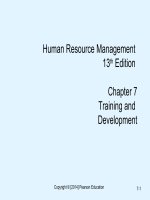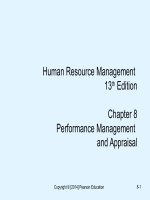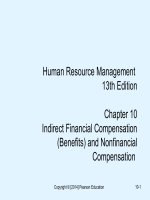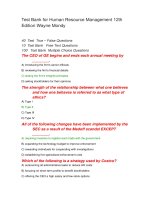Human resource management mondy 13th edition chapter 13
Bạn đang xem bản rút gọn của tài liệu. Xem và tải ngay bản đầy đủ của tài liệu tại đây (393.13 KB, 50 trang )
Human Resource Management
13th Edition
Chapter 13
Internal Employee Relations
Copyright © 2014 Pearson Education, Inc.
13-1
Learning Objectives
• Describe the importance of worker retention and
define internal employee relations.
• Explain the concept of employment at will.
• Explain discipline and disciplinary action.
• Describe the disciplinary action process, discuss
the various approaches to disciplinary action,
and describe the problems in the administration
of disciplinary action.
• Explain the need for emotional intelligence in
conducting disciplinary action.
Copyright © 2014 Pearson Education, Inc.
13-2
Learning Objectives (Cont.)
• Describe terminations, explain termination of
employees at various levels, and explain demotion
as an alternative to termination.
• Describe downsizing and explain the use of
ombudspersons and alternative dispute resolution.
• Describe transfers, promotions, resignations, and
retirements as factors involved in internal
employee relations.
• Explain problems with conducting disciplinary
action in the global environment.
Copyright © 2014 Pearson Education, Inc.
13-3
HRM in Action: Worker Retention
• During recession, it is easy to forget that talent
retention is critical
• Company must have ongoing strategy to retain
valued employees
• Virtually every topic in text can be viewed in
some manner as being part of retention strategy
• Provide means of preventing person from
seeking job with competitor and remaining with
firm
Copyright © 2014 Pearson Education, Inc.
13-4
Internal Employees
Relations Defined
Human resource activities associated
with movement of employees within firm
after they become organizational
members
Copyright © 2014 Pearson Education, Inc.
13-5
Internal Employee
Relations Activities
•
•
•
•
•
•
•
•
Discipline
Termination
Downsizing
Demotion
Transfer
Promotion
Resignation
Retirement
Copyright © 2014 Pearson Education, Inc.
13-6
Employment at Will
• Unwritten contract created when
employee agrees to work for employer
• No agreement as to how long parties
expect employment to last
• Approximately 2 of every 3 U.S.
workers depend almost entirely on
continued goodwill of employer
Copyright © 2014 Pearson Education, Inc.
13-7
Not Included
• Individuals with a contract for a
specified time period
• Those with collective bargaining
agreements
• Those with annual
contracts (i.e., teachers)
• Whistleblowers
Copyright © 2014 Pearson Education, Inc.
13-8
Exceptions to Employment-at-Will
Doctrine
• Prohibiting terminations in violation of
public policy
• Permitting employees to bring claims
based on representations made in
employment handbooks
• Permitting claims based on commonlaw doctrine of good faith and fair
dealing
Copyright © 2014 Pearson Education, Inc.
13-9
How Employers Can Protect
Themselves
• No statements suggesting job security or
permanent employment
• No statements during job interviews that
suggest a promise, such as, “You can
expect to hold this job as long as you
want”
• No hiring without a signed
acknowledgment of at-will disclaimer
Copyright © 2014 Pearson Education, Inc.
13-10
How Employers Can Protect
Themselves (Cont.)
• Clearly defining worker’s duties
• Providing good feedback on regular
basis
• Conducting realistic performance
appraisals on regular basis
• No law involving ethical
considerations for employment-at-will
Copyright © 2014 Pearson Education, Inc.
13-11
Discipline and Disciplinary Action
• Discipline: State of employee self-control
and orderly conduct
• Disciplinary action: Invokes penalty
against employee who fails to meet
established standards
Copyright © 2014 Pearson Education, Inc.
13-12
Effective Disciplinary Action
• Addresses employee’s wrongful behavior,
not employee as a person
• Should not be applied haphazardly
• Not usually management’s initial response
to a problem
• Normally are more positive ways of
convincing employees to adhere to
company policies
Copyright © 2014 Pearson Education, Inc.
13-13
The Disciplinary Action Process
EXTERNAL ENVIRONMENT
INTERNAL ENVIRONMENT
Set Organizational Goals
Establish Rules
Communicate Rules to Employees
Observe Performance
Compare Performance with Rules
Take Appropriate Disciplinary Action
Copyright © 2014 Pearson Education, Inc.
13-14
Disciplinary Action
• Word discipline comes from word disciple
– Translated from Latin, it means to teach
• Intent should be to ensure recipient sees
disciplinary action as learning process
Copyright © 2014 Pearson Education, Inc.
13-15
Approaches to Disciplinary Action
• Hot stove rule
• Progressive disciplinary
action
• Disciplinary action without
punishment
Copyright © 2014 Pearson Education, Inc.
13-16
Hot Stove Rule
•
•
•
•
•
Burns immediately
Provides warning
Gives consistent punishment
Burns impersonally
Problem: All situations are not the same
Copyright © 2014 Pearson Education, Inc.
13-17
Progressive Disciplinary Action
• Ensures minimum penalty
appropriate to offense is imposed
• Model developed in response to
National Labor Relations Act of 1935
• Involves answering series of
questions about severity of offense
Copyright © 2014 Pearson Education, Inc.
13-18
The Progressive Disciplinary Approach
Improper Behavior
Yes
Does this violation warrant disciplinary
actions?
No
No Disciplinary Action
Yes
Does this violation warrant more than
an oral warning?
No
Oral Warning
Yes
Does this violation warrant more than a
written warning?
No
Written Warning
No
Suspension
Yes
Does this violation warrant more than a
suspension?
Yes
Termination
Copyright © 2014 Pearson Education, Inc.
13-19
Suggested Guidelines for Disciplinary Action
Offenses Requiring First, an Oral Warning; Second, a Written
Warning; and Third, Termination
Negligence in the performance of duties
Unauthorized absence from job
Inefficiency in the performance of job
Offenses Requiring a Written Warning; Second, Termination
Sleeping on the job
to report to work one or two days in a row without notification
use of property
Failure
Negligent
Offenses Requiring Immediate Termination
Theft
Fighting on the job
Falsifying time cards
Failure to report to work three days in a row without notification
Copyright © 2014 Pearson Education, Inc.
13-20
Disciplinary Action
Without Punishment
• Process of giving worker time off with pay to
think about whether he/she wants to follow rules
and continue working for company
1. Employee violates rule, manager issues oral
reminder
2. Repetition brings written reminder
3. Third violation: Worker takes 1-3 days off (with pay)
to think about situation
• Important that all rules are explicitly stated in
writing
Copyright © 2014 Pearson Education, Inc.
13-21
Disciplinary Action Advice
• Managers often avoid disciplinary action,
even when it is in company’s best interest
• Many supervisors may be too lenient early
in disciplinary action process and too strict
later
• Proper time and place to administer
disciplinary action is crucial
Copyright © 2014 Pearson Education, Inc.
13-22
Trends & Innovations: Emotional
Intelligence Needed in Disciplinary
Action
• Ability to recognize and manage
emotions
• Capacity for recognizing own feelings
and those of others
• Quality needed in disciplinary action
Copyright © 2014 Pearson Education, Inc.
13-23
Termination
• Most severe penalty; should be most
carefully considered
– Termination of non-managerial and nonprofessional employees
– Termination of executives
– Termination of middle- and lower-level
managers and professionals
Copyright © 2014 Pearson Education, Inc.
13-24
Termination of Non-Managerial/
Non-Professional Employees
• If firm is unionized, termination
procedure is well defined in labor
agreement.
• Nonunion workers can generally
be terminated more easily.
Copyright © 2014 Pearson Education, Inc.
13-25









